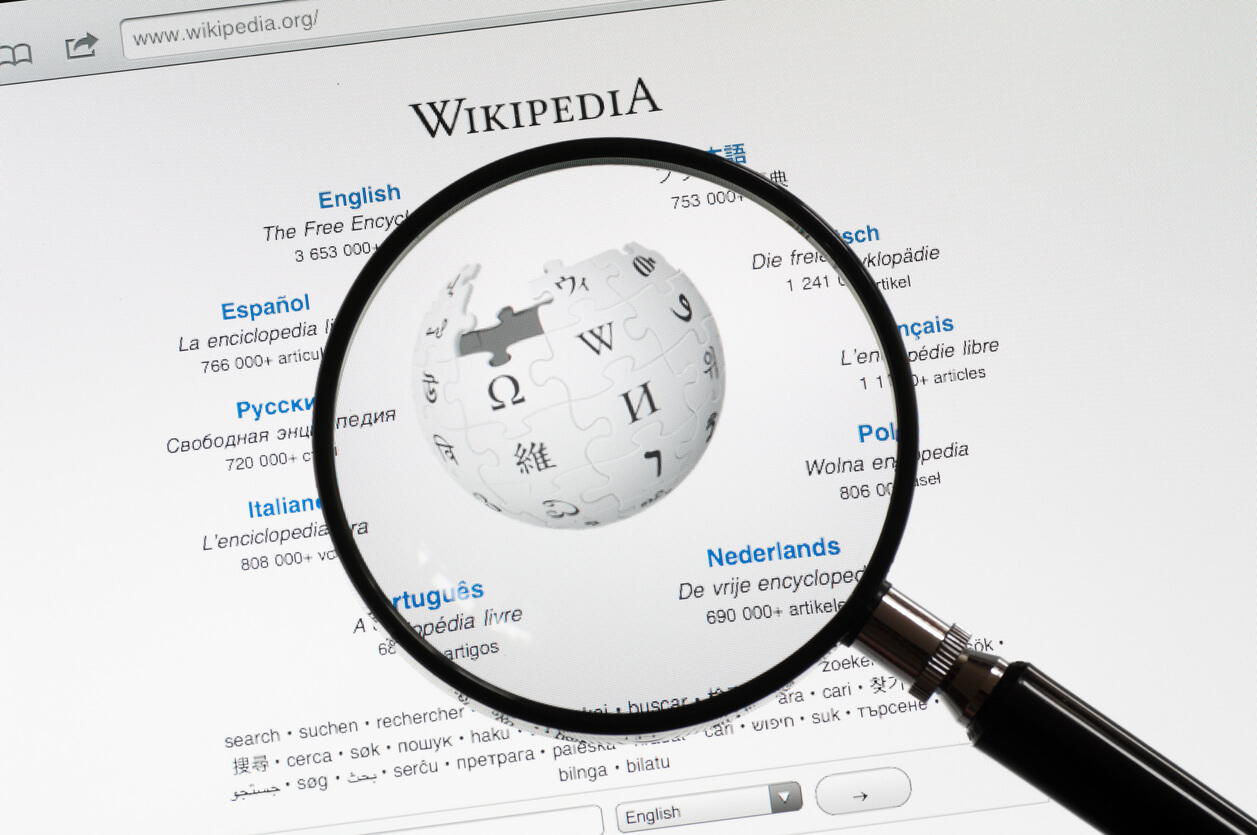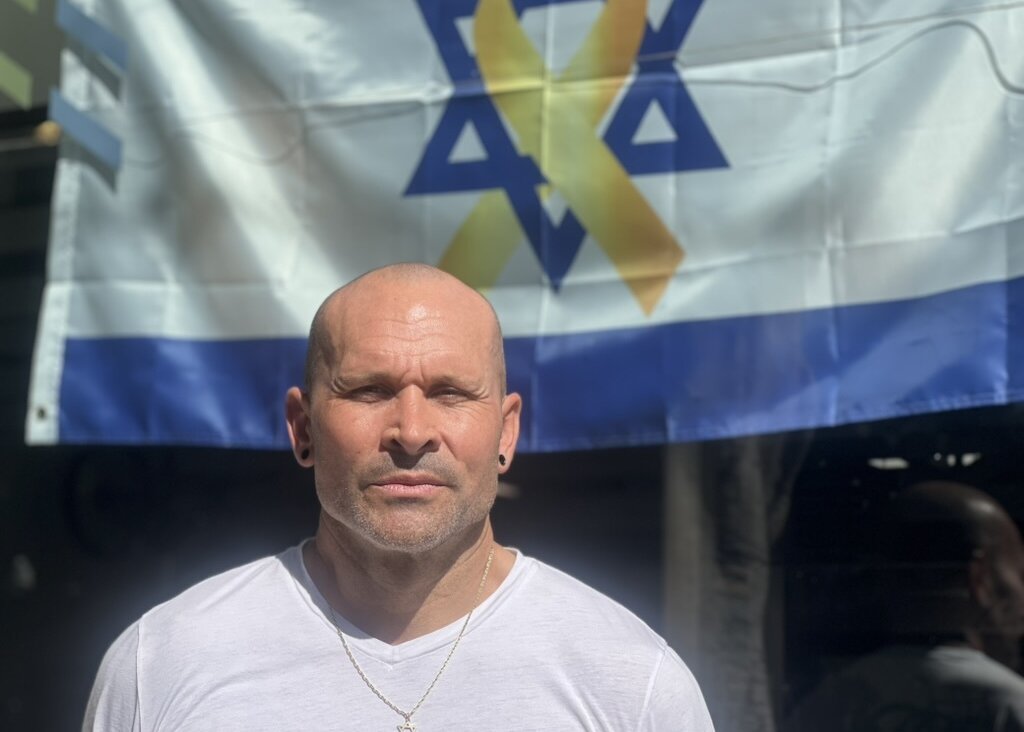New research documents show Wikipedia distorts the Holocaust
Historians have found that the English-language version of the online encyclopedia often quotes dubious sources that serve a false narrative, which glorifies the help Poles gave to Jews during the Shoah and minimizes their part in their extermination

The Wikipedia homepage. Photo by iStock
This article originally appeared on Haaretz, and was reprinted here with permission. Sign up here to get Haaretz’s free Daily Brief newsletter delivered to your inbox.
Wikipedia, the largest online encyclopedia in the world, systematically and intentionally spreads false, deceptive and biased information about the Holocaust. It even includes the accusation that the Jews were to blame for their own fate and of collaborating with the Nazis. These are the findings of a new study published last Thursday in the “The Journal of Holocaust Research” entitled “Wikipedia’s Intentional Distortion of the History of the Holocaust.”
“As a historian, I was aware for a long time of various distortions of the history of the Holocaust on Wikipedia. What I found shocking, was the sheer scale of the phenomenon, its lasting character and the small number of individuals needed to distort the history of one of the greatest tragedies in the history of humanity,” Prof. Jan Grabowski of the University of Ottawa told Haaretz.
“The impact of these distortions and falsifications is truly alarming; the Wikipedia articles which we looked at are being read by tens of thousands of people per month.”
The research found that over the past decade, a group of Wikipedia editors have been promoting a “skewed version of history,” one that serves a false narrative but which fits the ideology and version of history espoused by right-wing Polish nationalists. “Wikipedia’s articles on the Holocaust in Poland minimize Polish antisemitism, exaggerate the Poles’ role in saving Jews, insinuate that most Jews supported Communism and conspired with Communists to betray Poles (Żydokomuna or Judeo–Bolshevism), blame Jews for their own persecution, and inflate Jewish collaboration with the Nazis,” the authors write.
Grabowski and his colleague, historian Shira Klein of Chapman University in California, studied 25 articles in English as well as 300 back pages on Wikipedia, which provide a glimpse “behind the scenes” of the articles, such as “talk pages,” noticeboards and arbitrations that document the discussions of Wikipedia editors regarding every article. “What we found in these back pages is the mechanisms by which these editors get away with disinformation,” Klein told Haaretz.
The researchers discovered that Wikipedia editors chose to use deceptive and dubious sources of information and to quote studies or websites from marginal historians instead of citing the research of prominent historians in their fields. “They disparage established historians, praise fringe points of view and abuse the fact that the Wikipedia community doesn’t know the difference,” Klein noted.
The study authored by Grabowski and Klein found four areas in which the history of Polish Jewry during the Holocaust was distorted in the English-language version of Wikipedia.
“Four distortions dominate Wikipedia’s coverage of Polish-Jewish wartime history: a false equivalence narrative suggesting that Poles and Jews suffered equally in World War II; a false innocence narrative, arguing that Polish antisemitism was marginal, while the Poles’ role in saving Jews was monumental; antisemitic tropes insinuating that most Jews supported Communism and conspired with Communists to betray Poles (Żydokomuna or Judeo–Bolshevism), that money-hungry Jews controlled or still control Poland, and that Jews bear responsibility for their own persecution. Finally, distortionists inflate Jewish collaboration with the Nazis to make it seem an important part of the German policy of the extermination of European Jewry,” Grabowski and Klein wrote.
The study provides a large number of examples. In one, “the Wikipedia article ‘Polish Righteous Among the Nations’ echoes the same tropes of Polish heroism. ‘Many Polish Gentiles concealed hundreds of thousands of their Jewish neighbors.” Grabowski contradicts this and writes: “Considering no more than 30,000 (out of more than 3 million) Polish Jews survived the war and occupation on Polish territory, and that many of these survived without Polish help, to argue that hundreds of thousands of Jews found shelter in Polish homes is nonsensical.”
The entry on the rescue of Jews by Poles during the Holocaust states that “thousands were executed by the Germans solely for saving Jews.” The entry also states that 3 million (non-Jewish) Poles were killed during World War II. Grabowski argues that all of these numbers are wrong. The total number of (non-Jewish) Poles who lost their lives in the war is about 2 million rather than 3 million and of that figure the number executed for saving Jews is fewer than 800 and not “several thousand,” he said, as had been claimed.
Another entry, the History of the Jews in Poland, states: “Although the Holocaust occurred largely in German-occupied Poland, there was little collaboration with the Nazis by its citizens,” referring to the Poles. Such a claim is not backed up with any historical sourcing and is not true, Grabowski wrote. “This claim has no footnote or truth to it; we know from voluminous research that betrayal of Jews by Poles was common.”
The entry on collaboration with the Axis powers is another example of an article in which matters were distorted, without any reliance on sources or that cited questionable sources. The section on Poland states that “the Nazi authorities ordered the mobilization of prewar Polish officials and the Polish police (the Blue Police), who were forced, under penalty of death, to work for the German occupation authorities.”
For his part, Grabowski claims that there is no documentation of a single Pole being executed for refusing to serve under the Germans and that the Germans never threatened such a punishment. The entry also states that many Polish police followed German orders “reluctantly” and that “some acted as agents for the Polish resistance.”
Grabowski, who conducted an entire study on the Polish Blue Police during the period of the Holocaust, actually found proof that some of the Polish policemen “served the Germans with zeal and devotion” – details that were not included in the Wikipedia entry.
The Germans did indeed impose severe punishments on those refusing to serve in the new police force, but not the death penalty, and no documented case exists of a Polish officer being executed for such refusal, he noted.
“While many officials and police reluctantly followed German orders,” the Wikipedia entry continues, “some acted as agents for the Polish resistance.” This phrasing suggests Polish collaborators were at most reluctant, never willing.
The same Wikipedia entry states that 3,500 Poles who had collaborated with the Germans were sentenced to death by the Polish underground during the war. Grabowski rebuts that, writing that he is only aware of seven such cases and that in general, the underground did not direct its efforts at all to hunting down Poles who had cooperated with the Germans in persecuting the Jews.
The online encyclopedia entry on the rescue of Jews by Poles during the Holocaust states that the Home Army – the large Polish resistance group – had warned the world about the Holocaust via reports from a Polish soldier, Witold Pilecki, that were then provided to the Polish government in exile in London by courier Jan Karski.
“Nearly everything is wrong here,” Grabowski writes. “First of all, as we know today, the report regarding the destruction of Polish Jewry was delivered to the Polish authorities in London, not by Jan Karski (nowadays celebrated in film and popular literature), but by another courier. Second, Pilecki wrote his report in the summer of 1943, by which point the vast majority of Polish Jews had already been murdered, and Jan Karski, the courier, had left Poland in the fall of 1942. Karski (or any other courier) simply could not have carried abroad a report written nearly one year after his departure. Finally, Pilecki’s 1943 40-page report (the so-called Report W) described the situation at Auschwitz I main camp, but barely mentioned the ongoing extermination of Jews in nearby Auschwitz II–Birkenau and instead focused on the Polish camp resistance movement.”
The Wikipedia entry also mentions the Ulma family, a family of Polish Righteous Gentiles who saved Jews during the Holocaust. The couple and their six children were killed by the Nazis after hiding Jews in the village of Markowa in Nazi-occupied Poland. Grabowski noted that the entry deliberately omitted the fact that the family had been turned over to the Germans by a Polish policeman and also failed to mention that “most of Markowa’s Jews were delivered for execution to the Germans by their own Polish neighbors ….”
The entry on Nazi crimes against the Polish nation states: “About 20,000 villagers, some of whom were burned alive, were murdered in large-scale punitive operations targeting rural settlements suspected of aiding the resistance or hiding Jews and other fugitives.” Grabowski also challenges that.
“Individual shootings were reported on numerous occasions, but never were entire village populations targeted for helping Jews. It is true that the Germans executed 96 men in the abovementioned village of Białka. It is not true, however, that this act of terror in any way stemmed from villagers helping Jews. The German crime was an act of reprisal for the assistance that the peasants were thought to have given to the local communist and left-wing partisans,” he writes.
Then there is the entry on the 1946 Kielce pogrom, in which after the war ended, 42 Polish Jews, most of them Holocaust survivors, were killed. The entry devotes considerable space to the conspiracy theory of Soviet involvement in the pogrom. For his part, Grabowski writes that “this theory has been roundly rejected by all serious scholars and today finds an audience only among fringe Polish nationalists and conspiracy theorists wishing to prove that Communist Soviets, not Polish antisemitic masses, bore responsibility for the massacre.”
In other entries related to Polish-Jewish relations, Grabowski and Klein found indications of antisemitic prejudice, including claims that the Jews were genetically different from the Poles and refused to integrate into Polish society. The Wikipedia entry on the history of the Jews in Poland states, for example, that the Jews have “specific physical characteristics.”
The study also found that many encyclopedia entries described Jews as collaborators with the Nazis. One even asserted that Poles who had saved Jews were concerned that they would be turned over to the Germans by Jewish collaborators. Wikipedia also describes the Judenraete, the Jewish councils set up on orders of the Nazis, as collaborating with them.
In response, Grabowski wrote, “Jewish council members were hardly ‘self-enforcing intermediaries for managing Jewish communities.’ They were tightly supervised by the German police …. Judenrat members who failed to comply usually faced imprisonment and death, and most Jewish policemen were murdered only shortly after the other Jews in their local community.”
“Placing those people on equal footing with Polish policemen and administrators, who had a real choice, who could kill, and who could refuse to kill with impunity, gravely distorts history,” Grabowski noted.
In the entry Collaboration in German-Occupied Poland, Grabowski and Klein found that “Jewish collaboration with the Nazis takes up more space than the Ukrainian, Belorussian and ethnic German collaboration combined.”
“Jews helped the Germans in return for limited freedom, safety and other compensation (food, money) for the collaborators and their relatives,” the Wikipedia entry states. “Some were motivated purely by self-interest, such as individual survival, revenge, or greed; others were coerced into collaborating with the Germans.”
Grabowski counters: “The editors writing these sentences seem to forget that Jewish collaborators were, above all, victims and hostages of a choice-less choice. They became ‘forced traitors,’ to use Doris Tausendfreund’s expression, in order to preserve their own lives, or the lives of their loved ones.”
An earlier Wikipedia entry entitled the Warsaw concentration camp has attracted considerable media attention in recent years. It had alleged that more than 212,000 people, the vast majority of whom were Poles, perished in the camp. Haaretz reporter Omer Benjakob, who wrote an extensive article on the subject in 2019, described the entry as “the longest-running hoax ever uncovered on the online encyclopedia.”
The entry was based on an actual event – the establishment of a small concentration camp in the second half of the war. But contrary to what the entry alleged, there were no gas chambers there and mass extermination of Poles. Even though it was patently false and based on a conspiracy theory, the entry remained online for 15 years in English and was translated into 12 other languages on Wikipedia and viewed by about half a million people. Details from the article also appeared in other prominent entries on the Holocaust.
Grabowski and Klein’s study did not find a link between the government or any other official authority in Poland and the manner in which the Wikipedia articles were edited. Nevertheless, Grabowski and Klein cite an email exchange leaked last year that indicates that Polish officials at the highest level were aware of Wikipedia’s influence on public discourse and its impact in shaping the memory of the Holocaust.
In 2018, at the height of a diplomatic crisis between Israel and Poland over Poland’s Holocaust Law, an adviser to Prime Minister Mateusz Morawiecki sent the email to the prime minister’s chief of staff. The adviser wrote that he had approached a Polish diplomat and asked her “to find someone who could start to position the Israeli sites in Google and to correct the Hebrew entries in Wikipedia.” The writer cautioned that “we need to be super discreet on this score.”















